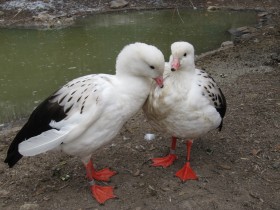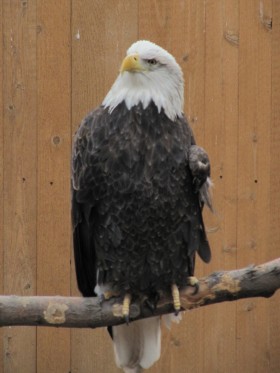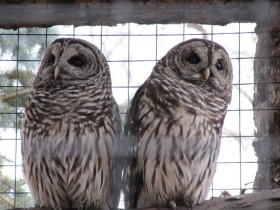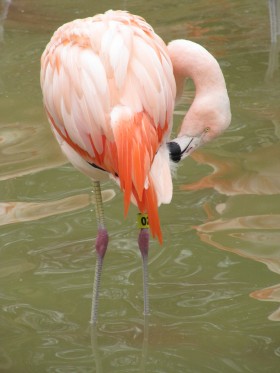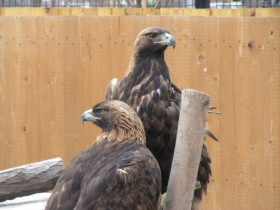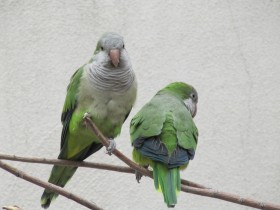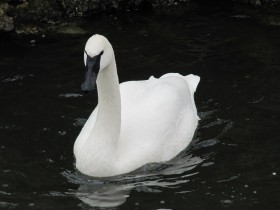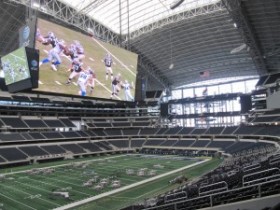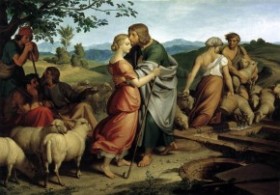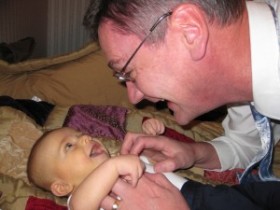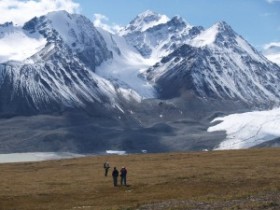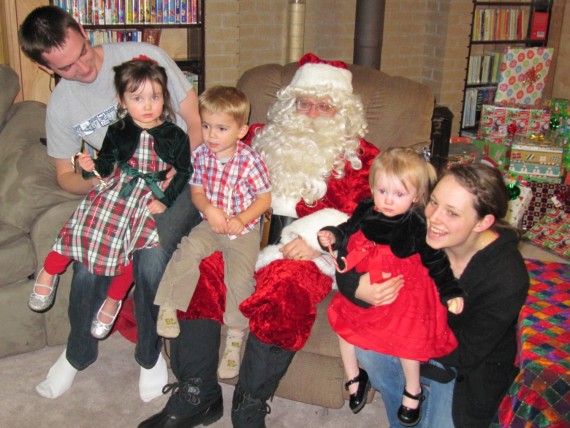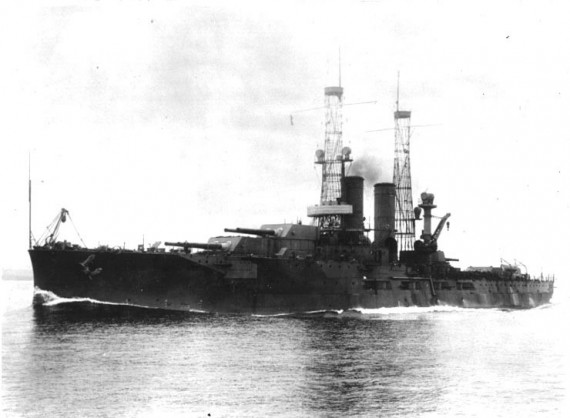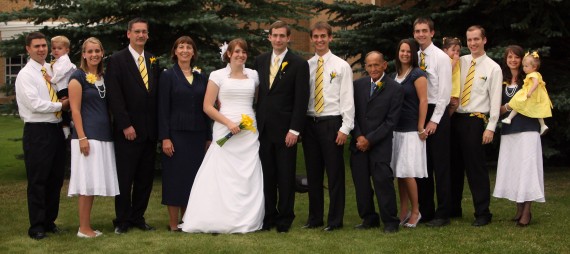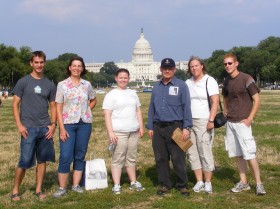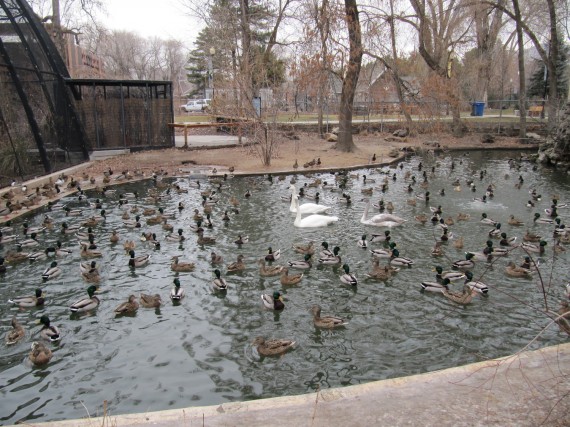 Tracy Aviary has free admission (with a $1 conservation contribution) on Winter Wednesdays through February. So I went with my grandson and other family members to see a surprising number of birds for a cold day in December.
Tracy Aviary has free admission (with a $1 conservation contribution) on Winter Wednesdays through February. So I went with my grandson and other family members to see a surprising number of birds for a cold day in December.
I enjoyed seeing Bryson’s reaction to the birds and also taking a few photographs (click to enlarge) of the feathered residents.
American White Pelican
Utah’s largest native bird, the American White Pelican weighs up to 30 lbs with a 9 foot wingspan, and lives around freshwater wetlands and lakes.These birds do not dive beneath the water for their prey, but instead hunt along the surface in groups, herding and corralling fish toward shore into an ever-tightening half-circle. The pelicans then dip forward in simultaneous motion to scoop prey into their expanded pouches.
One of the largest breeding populations of American white pelicans in the world, often over 20,000, gathers on Great Salt Lake’s Gunnison Island, raising thousands of young each year. Pelicans can also be seen at Farmington Bay Wildlife Management Area, Antelope Island, Stansbury Lake, Ogden Bay, Willard Bay, Bear River Migratory Bird Refuge, Salt Creek Wilderness Management Area, and Cutler Marsh.
Andean Goose
The Andean Goose resides around wetlands in the Andes, above 10,000 feet, unless forced to descend to lower altitudes by winter snow.These birds avoid swimming except in emergencies and are mainly vegetarian, feeding on grasses, sedges (perennial plants that resemble grasses), and fleshy aquatic plants.
The Andean Goose builds a shallow nest of vegetation on the ground and lays 5-10 eggs with incubation around 39 days.
Bald Eagle
Bald eagles are found only on the North American continent living near open water from Alaska to Northern Mexico.Their primary food source is fish but they also feed on carrion, waterfowl, and small mammals. Adult male eagles generally weigh about 9 pounds and adult females typically weigh between 12 and 13 pounds. Adult eagles have a wing span of up to 7 feet. The distinct white head and tail and yellow beak of the mature bird is developed between 4-5 years of age.
Pairs typically mate for life, which in the wild can be between 30 and 35 years. In captivity, they have been known to live up to 50 years.
Bald Eagles have such keen eyesight that they can spot fish from up to a mile high in the air and will dive at up 100 miles per hour. Eagles have been observed lifting prey weighing well over 4 pounds.
Barred Owl
The Barred Owl is native to North America and goes by many other names but is best known as the Hoot Owl because of its call. The adult is up to 2 feet long with a 4 foot wingspan and weighing 1.1 to 2.3 lbs. It has brown eyes; all other owls have yellow eyes.The owl lives in large forests near swamps or other water in Canada, the eastern United States, and Mexico but in recent years it has spread to the western United States. Populations increase faster in suburban settings than in old growth forest. The main danger to owls in suburban settings is from cars but the increased offspring offset deaths.
The Barred Owl’s nest is often in a tree cavity, perhaps taking over an old nesting site made previously by another bird or squirrel. The female incubates her eggs while the male brings her food. Hatching takes place approximately 4 weeks later.
These owls have few predators, but young, unwary owls may be taken by cats. The most significant predator of Barred Owls is the Great Horned Owl.
The principal prey of this owl are meadow voles, mice and shrews, rats, squirrels, rabbits, bats, moles, opossums, mink, and weasels. Birds are taken occasionally including smaller owls. It occasionally wades into water to capture fish, turtles, frogs and crayfish.
Blue-coated Bryson
Unique to Utah, the Blue-coated Bryson is only seen with this plumage in the winter months.He feeds on mostly what is given to him but will forage for snacks at any time. He is particularly fond of cheese.
Bryson can be seen at times carrying a stick that he likes to poke objects with or drag in the soil. He is not looking for tasty grubs but is merely playing, as this species is prone to do.
It is essential that he remain free roaming as humans do poorly in captivity. However, the young (and some adults) have to be monitored constantly to keep them from mischief.
The Blue-coated Bryson thrives in the traditional family habitat, which in recent decades has been threatened.
Chilean Flamingo
Chilean flamingos live in flocks of dozens to tens of thousands of birds along shallow, brackish lakes and rivers throughout South America.Flamingos are not born pink but turn pink after two years of eating shrimp and tiny algae.
While their feet stir up algae, their beaks tip upside-down in the water, acting as a filtering system to keep food in and strain water out.
By tucking one leg up into the soft down on their stomach, flamingos release less heat along the surface area of their legs to regulate their body temperature more effectively.
Chilean flamingos build two-foot high mud nests on which the female lays one white egg on top.
Golden Eagle
In addition to North American, Golden Eagles are found in Europe, North Africa, and Asia. They favor cliffs, mountains, and other rugged terrain. These birds have a body length reaching 3 feet and a wingspan over 7 feet wide.Golden Eagles mature at the age of 4 and generally mate for life.
When hunting, pairs divide the labor – one bird chases its prey to the point of exhaustion while the other swoops in for the kill. They use their talons to kill and carry their prey. While they can reach flight speeds of 80 miles per hour, their average speed is 30 miles per hour. When they dive for prey, their speed can exceed 200 miles per hour.
Their diet includes rabbits, squirrels, prairie dogs, groundhogs, skunks, fox, and sometimes much larger mammals. They also prey on other birds, such as crows, pheasants, and meadowlarks. Because of the bird’s impressive hunting skills they only migrate during occasional food shortages and rarely long distances.
Keel-billed Toucan
The Keel-billed Toucan lives in Southeast Mexico through Northern South America. They are a very social species and live in groups of 6-12 birds.Female Keel-billed Toucans are smaller and have a shorter bill than the males. The species sleep in tree cavities with other Toucans. They fold their tails up and tuck their beaks under a wing to make more space.
They eat fruit but also enjoy small birds, eggs, reptiles and insects. These birds have 2-4 eggs each clutch; both male and female help to incubate the eggs.
This bird was part of the free-flighted encounters with Tracy Aviary trainers.
Monks Parakeet
The Monks Parakeet is globally very common and in Argentina, Brazil and Uruguay they are regarded as agricultural pests. They are found in open woodlands, palm forests and palm groves as well as urban habitats. They eat seeds, nuts, blossoms, insects, and grasses.The Monk Parakeet is the only parrot that builds a stick nest, in a tree or on a man-made structure, rather than using a hole in a tree. They build a single large nest with separate entrances for each pair. In the wild, these colonies can become quite large, with pairs occupying separate “apartments” in nests that can reach the size of a small automobile.
These nests can attract many other tenants including birds of prey such as the Spot-winged Falconet, ducks such as the Yellow-billed Teal, and even mammals. Their 5-12 white eggs hatch in about 24 days.
Peafowl
Peafowl are a species of pheasant native to India and Sri Lanka and are best known for the peacock’s extravagant eye-spotted tail display during mating season.While wild peafowl live in forests and open grassy areas, peafowl can now be found all over the world as pets and exhibit birds.
They are content to remain free roaming and fully flighted wherever they have adequate food and protection from predators.
The male is called a peacock, the female a peahen, and the offspring peachicks. The adult female peafowl is grey and/or brown. Peachicks can be between yellow and a tawny color with darker brown patches.
Red-crested Turaco
The Red-crested Turaco measures 20 inches from beak to tail and is a fruit-eating bird from western Angola. They are so abundant in Africa that they are considered a pest. It inhabits forest and savanna and lives 5 to 9 years. The female lays 2 to 3 eggs but the male helps in the 21 to 24 days of incubation.Turacos are the only birds to possess true red and green color. In most birds, the color is a reflection produced by the feather structure. The turaco’s red and green pigments both contain copper.
These birds have mobile outer toes, which they can rotate forward or backward. They live in large flocks of up to 30 individuals. During courtship, the male will feed the female.
This bird was part of the free-flighted encounters with Tracy Aviary trainers.
Southern Lapwing
The Southern lapwing is a ground-dwelling wading bird found throughout South America near lakes, riverbanks, open grassland and even urban areas, such as soccer fields.During the breeding season, parents produce alarm calls that cause their chicks to crouch in the vegetation when a potential predator is near. It has such an alarming call that farmers will use this bird as a guard for livestock.
The timing of breeding for Southern Lapwings is strongly related to the rainy season. They create a nest on the ground supported with twigs and the female will lay 2 to 4 black-spotted brown eggs.
It feeds mainly at night, often in flocks, eating insects and other small invertebrates.
In Uruguay, due to its bold and combative nature it has become mascot of the Uruguay national rugby team.
Trumpeter Swan
The Trumpeter Swan is native to Northern North America and is the largest waterfowl found in its range. These birds can live over 24 years in the wild and form tight pair bonds with their mate that lasts a lifetime.Females lay 1-9 eggs in a large nest of vegetation near water, and eggs are incubated by both parents. The grayish-brown Cygnets leave the nest within 24 hours of hatching to swim and feed with the parents.
During the feeding at Tracy Aviary, a duck was perceived by the swans to be eating their food and was dealt with accordingly.
Feeding Time Video
Sources
- Tracy Aviary
- Extracts from various Wikipedia bird articles.
Credits
- Thanks to Jill Willoughby for the video and the free-flighted encounters photographs.


